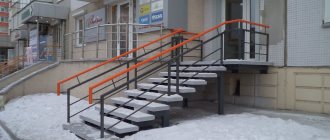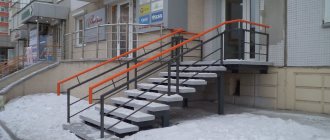Residents of multi-storey buildings, and especially the first floors, will be interested in the possibility of privatizing the basement. In the future it is possible to reconstruct it to improve living conditions. First you should find out how to privatize a basement in an apartment building. There are rules and regulations for this process that you will need to adhere to.
Privatize the basement in an apartment building
Legislative acts
Article 36 of the Housing Code allows for the privatization of a basement in an apartment building. According to the regulatory document, these premises are in shared ownership. The size is calculated based on the square footage of the apartment.
You will need to obtain permission legally. In new houses, the project documentation is carefully studied. Additionally, it should be noted that in these matters the court most often takes the place of the property owner. Consent will need to be obtained from the housing community and other owners. Today, the privatization process is free and is carried out without a specific deadline.
You will need to take into account a number of nuances and go through many authorities.
Basement under the apartment
Is it possible to privatize a basement if it is located directly under the property itself? Thanks to this, it will be possible to significantly increase the square footage and redesign the “lower floor”.
In this video we will look at how to privatize the basement of an apartment building:
After conducting an inventory of the basement, according to Art. 36, the rights of other residents must not be infringed. That is why a meeting of residents is held in advance. It may also decide to transfer property rights to third parties.
Decorating a basement for your property
Re-registration of the owner is carried out after verification. Documents are first prepared at the Technical Documentation Bureau. In practice, this is possible through one of the following methods:
- Description of the basement area and its other features. It is important to draw up project documentation correctly. You can do this yourself or use the services of a special organization.
- If a decision has not been made to carry out reconstruction, then it is carried out preliminary. After this, the area is legitimized through special examinations. The Technical Documentation Bureau issues the final permit for reconstruction.
All changes made must be documented. When re-equipping, you should pay attention to the following nuances:
- Permission for reconstruction will be signed only if utility specialists can access the site without any special obstacles. This is necessary for repair work.
- The foundation walls are erected in such a way that all fire safety requirements are met. In this case, you will need an ASG. It fully meets the requirements for repair work. To place everything necessary for a fire, you can use ready-made shields.
Simple apartment reconstruction
In the case where simple transformations of the premises take place, the redevelopment can be legalized after the repairs have been carried out, without obtaining prior permission for the redevelopment. But a condition must be met: such transformations must be insignificant. These types of changes include:
- Demolition and relocation of interior partitions (not load-bearing walls), as well as installation of openings in them. This rule does not apply to cases of moving or dismantling partitions between kitchen and living spaces;
- Construction of new partitions between rooms, if this does not entail an increase in the load on the floor;
- Elimination of doorways in walls of any type.
To carry out this work, a special project will not be required; you will only need to provide a sketch with the planned changes applied to the existing floor plan.
Such permission can be obtained after a preliminary stage, as a result of which the object is transferred to housing stock and registered as property. For owners of private houses, no preliminary stage is required.
When constructing a capital building by the owner, it is permissible to provide for the use of the space under the roof as an attic in advance, when preparing design documentation and obtaining permission to build a house.
When reconstructing an attic, it is necessary to carry out redevelopment taking into account changes in the design documentation, since in this case it will be necessary to carry out an appropriate analysis based on calculations and guaranteeing the safety of the reconstruction. The calculations carried out, in turn, require reconciliation with the regulatory regulations provided for authorizing certain types of reconstruction.
The project is compiled using topographic information from the floor plan obtained from the BTI. Placed on a separate sheet, the indicated information is supplemented by the project, which includes the built-on object.
The result is a perspective of newly formed housing, with a room or attic built on top of the apartment. Such a project is certified by the architectural department of the administration.
It also requires approval from authorized authorities:
- fire service;
- sanitary and epidemiological station.
After preparation and certification of the project, its registration in Rosreestr is required.
Only after this is it possible to introduce planned inseparable improvements focused on project standards.
We invite you to read: Succession in international law
Getting permission
At the first stage of re-registration, you need to create an application. The process is possible if there are no communications on the territory that provide the house with everything necessary. Otherwise, a separate entrance is made in this part of the building for utility workers. Only blocks can be used as walls. If it is necessary to carry out repairs, load-bearing walls and supports should not be damaged during the repair.
A person is advised to hold a meeting of owners. There a vote is taken on the issue of alienation. This is enough to privatize this part of the property. However, the majority of residents must be present at the meeting. The decision is considered made if at least half of all residents have arrived. They must also unanimously express their positive decision.
Forgery of documents is not only illegal, but also severely punishable under current laws. For example, one of the dissatisfied residents may well contact the supervisory authorities to check the voting results.
The owners regulate the issues of transferring individual plots for privatization. That is why coordination is necessary.
Invalid changes
The law prohibits such changes as:
- Expansion of the kitchen space and/or sanitary unit into the living space by more than 25% of the original living area;
- If the kitchen is equipped with a gas stove, when combining the kitchen and living space, according to fire regulations, the actual result is an expanded kitchen, which, according to sanitary rules, cannot be located above the living space (here we are talking about the layout of the adjacent room located below). However, if the neighbors below carry out a similar redevelopment with adjustments to the inventory plan, this problem disappears. Another option for owners of a gas stove, which allows you to dismantle the wall completely or partially: install a sliding partition that will separate two rooms, while leaving the opportunity to open the space if necessary. If the apartment is one-room, combining the living space and kitchen with a gas stove is prohibited, since in this case the living space simply ceases to exist;
- Elimination of load-bearing structures. The solution in this situation would be partial dismantling of the wall or an opening in the wall. You must first carry out a technical inspection of the house, develop strengthening schemes, coordinate the work and obtain permission from the authorities. In the case when legalization occurs after the fact, all finishing coverings of the opening are opened so that the engineer has the opportunity to examine the condition of the supporting structures, the presence of reinforcements, etc.
- Reduction, transfer or dismantling of common building communications. This may include: ventilation openings and ducts of ventilation systems, water pipes, and in some cases, radiators of the heating system;
- Increasing the balcony space due to the area of the living room (however, it is allowed to construct an arch no more than 1 meter wide);
- Placing a kitchen or sanitary facilities (bathroom, toilet) above living spaces, placing bathrooms above kitchens. The only option that allows a bathroom to be placed above the kitchen is a two-level apartment;
- Equipment for heated floors powered from the general house network, placement of heating systems in cold rooms (balconies, loggias);
- Construction of a bathroom doorway (equipped with a toilet) leading directly to the living space. The exception is apartments where people with disabilities live;
- • Any work that entails difficulty in accessing general life support systems, deterioration of living conditions for citizens or violation of their rights, or reduction in the strength of the house structure.
We invite you to familiarize yourself with: The total amount of the contract is the sum of all
Required documents
After receiving consent for privatization, a person will need to start collecting the necessary documents. Next, you will need to contact Rosreestr with a corresponding application. Basements are transferred for privatization on the basis of the following documents:
- The premises are the property of the occupants and therefore an appropriate statement of consent must be provided from them.
- Reconstruction of the basement is possible after submitting the minutes of the meeting of all residents.
- Assessment of technical condition and availability of a passport from the BTI.
- The registration procedure begins after providing a receipt for payment of the state duty.
- Cadastral documents.
The government agency determines whether you have grounds to apply for privatization. If approved, the re-registration process takes a week.
Privatization of illegally occupied premises
Similar cases occur in practice. Often, owners occupy basement areas without permission. They can claim that they did the refurbishment at their own expense and that this is enough to legally own the premises. However, as described earlier, this is not the case. If a general meeting of owners was held with positive results, but without further action on privatization, the person cannot be considered a copyright holder.
To register ownership of such premises, it is necessary to hold a new meeting of residents to redistribute the owners and change the owner. Most often, this problem exists in old housing stock, where distribution took place a long time ago and without legal registration.
Registration procedure
Residents of the basement need to know what the privatization of a basement technically consists of:
- You can build a basement or attic above the apartment after a meeting of all residents. They should be warned about this through an announcement. Voting takes place at the meeting. An official protocol will also need to be drawn up.
- A person is advised to carefully study the legislation that is used to regulate relationships in this area. Next, a package of documents is collected. It includes statements from all residents with a signature and its transcript. Documents are certified by a notary.
- Interference with the foundation structure is considered unacceptable. All reconstruction projects must be agreed upon and included in the contract. It is acceptable to include various materials, such as concrete, in the original plan.
- The collected package of documents will need to be submitted to a special commission, which is created at the local level.
- If you need to do construction work in the basement, you will additionally need to obtain permission from the City Architecture Department.
Collect the necessary documents for privatization of the basement
- An application for privatization of property will need to be submitted to the court. It must be supplemented with permits.
- Ownership rights are finally transferred after inventory. The process is carried out by representatives of the BTI or cadastral service.
Completion of all procedures is possible subject to payment of the state fee. The receipt is attached to the documents and submitted to Rosreestr. For apartment owners, the process will not be difficult. However, it will require significant funds to be allocated.
The need to legitimize redevelopment - how to legitimize an apartment redevelopment that has already been done
If an illegal redevelopment of an apartment is discovered (for example, in the event of an emergency, during an inspection, or as a result of denunciation by neighbors), the owner may face a significant fine. The redevelopment will have to be legalized within 3 months, otherwise the owner will be fined again. If the identified redevelopment was carried out in violation of the requirements, the owner will be obliged to return the premises to its original form and compensate for the damage caused to other residents. Failure to comply with this requirement will entail the sale of the apartment at auction, eviction and deprivation of ownership.
It should be remembered that significant intervention in the structure of a house without a technical report and a redevelopment project can cause the house to collapse or be declared unsafe.
1. As in the case of legal redevelopment, after the work is completed, it is necessary to invite a specialist from the BTI who will validate the changes. The BTI must provide:
- Old registration certificate;
- Application for calling a technician;
- Certificate of entitlement;
- Identity document;
2. Obtaining a conclusion from the SES on compliance with standards;
3. Drawing up an order for the production of a technical project. To do this, you should contact the BTI or another design organization with authority;
4.Receiving a referral to court from the district administration;
5.Litigation. List of documents for applying to court:
- Claim to preserve the redevelopment carried out;
- Title documents (originals and copies);
- Conclusion from the SES and the design organization;
- Two versions of the technical passport: original and with amendments;
- Consent of the residents of the apartment, as well as its owner, if the redevelopment was carried out by the tenant;
- If a building is recognized as a cultural or architectural monument, a conclusion is required that no damage was caused to the building.
6. In case of obtaining permission from the judicial authorities, it is necessary to complete a package of documents (personal documents, all consents, conclusions and permits received, documents on ownership). Then the owner proceeds in the same way with legal redevelopment: applying to the BTI, then to the Cadastral Chamber.
- An initial application to the BTI will cost about 600 rubles and will take approximately two weeks;
- The applicant can obtain permission from the district administration within 45 days from the date of submission of documents;
- The financial costs of redevelopment will depend on the complexity of the work and the choice of materials. As for the timing, as a rule, about 4 months are allotted for this procedure;
- The redevelopment project will cost at least 2,000 rubles and will take one to two weeks;
- The fine for illegal redevelopment for citizens will be from 2 to 2.5 thousand rubles, in case of violations - up to 5 thousand rubles. For officials and legal entities the figures are more impressive - the amount of the fine can reach 300,000 rubles.
- A certificate of completion of work will be issued within 10 days from the date of taking the necessary measurements;
- Correcting the technical package of documents will cost at least 4,000 rubles;
- Obtaining approvals does not require financial costs if you apply to the authorities yourself; if you contact specialists, the amount will vary from 10,000 to 35,000 rubles;
- A new technical passport can be obtained within two weeks; on average, you will have to spend about 1,200 rubles;
- A new Cadastral passport is issued within five days from the date of submission of documents, the cost of the service for individuals is from 50 rubles.
We invite you to read: How to recognize ownership of a house or apartment through the court in 2021
Cost and terms
The privatization of a block, which was planned by a person, ends with the issuance and registration of a technical passport in the BTI. The state duty is paid immediately before privatization. For residents of the first floor, this is an opportunity to expand their living conditions. For residents of the house, privatization means receiving property that in the future can be rented out to various commercial structures.
Commercial basements provide space for small businesses to get the growth they need. Technical floors can be easily converted. In times of industry crisis, this is a unique opportunity to stay afloat.
Compared to bankruptcy, privatization is a profitable solution.









